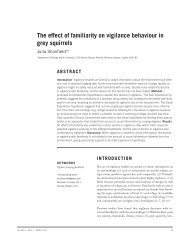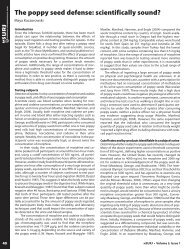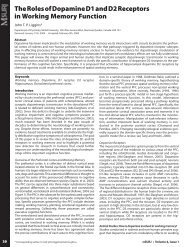the entire issue - McGill Science Undergraduate Research Journal ...
the entire issue - McGill Science Undergraduate Research Journal ...
the entire issue - McGill Science Undergraduate Research Journal ...
Create successful ePaper yourself
Turn your PDF publications into a flip-book with our unique Google optimized e-Paper software.
Operational transformation in cooperative software systems<br />
1.<br />
Operation generation: an operation is specified by <strong>the</strong> user,<br />
and broadcast to all of <strong>the</strong> o<strong>the</strong>r clients.<br />
As previously mentioned, <strong>the</strong>se transformation functions are generated<br />
for each pair of operations in <strong>the</strong> application space.<br />
2.<br />
3.<br />
Operation reception: an operation request is received from<br />
ano<strong>the</strong>r site.<br />
Operation execution: an operation request is executed at <strong>the</strong><br />
site.<br />
The generated transformation functions are basically generated such<br />
that <strong>the</strong> position in which <strong>the</strong> operation is applied is transformed<br />
by an offset relative to <strong>the</strong> o<strong>the</strong>r operation. For example, one of <strong>the</strong><br />
most basic inclusion transformations between two insert operations<br />
can be represented as follows.<br />
From <strong>the</strong>se activities, we have two major sets of algorithms that handle<br />
conflict resolution for <strong>the</strong> system: <strong>the</strong> low-level operation transformation<br />
algorithms, and <strong>the</strong> high-level control (or integration)<br />
algorithms. The control algorithms handle <strong>the</strong> operation models<br />
at generation and reception, by generating a set of corresponding<br />
transformation algorithms, which <strong>the</strong>n transform <strong>the</strong> target operation<br />
model before executing it at <strong>the</strong> received site (6).<br />
We will discuss <strong>the</strong> specific actions taken during each of <strong>the</strong> activity<br />
phases when we compare <strong>the</strong> different control algorithms possible<br />
in OT.<br />
Operation transformation<br />
Operation transformation relies on satisfying several properties that<br />
ensure that <strong>the</strong> system is correct at each point. These are lower-level<br />
properties than <strong>the</strong> consistency model described previously, but<br />
not all properties are satisfied by each control algorithm, and where<br />
<strong>the</strong>se properties are ensured may differ between each one. These<br />
transformation properties are often divided up into two different<br />
types: convergence properties and inverse properties (1, 2).<br />
For an insert function with signature insert(p, c, s) where:<br />
•<br />
•<br />
•<br />
p = position of <strong>the</strong> character to be inserted<br />
c = character to insert<br />
s = site priority of <strong>the</strong> client<br />
Then, <strong>the</strong> transformation function is <strong>the</strong> algorithm:<br />
Algorithm 1 - Inclusion transform with two inserts<br />
if (p 1<br />
< p 2<br />
) <strong>the</strong>n<br />
return insert(p 1<br />
, c 1<br />
, s 1<br />
)<br />
else if (p 1<br />
== p 2<br />
) and (s 1<br />
< s 2<br />
) <strong>the</strong>n<br />
else<br />
end if<br />
return insert(p 1<br />
, c 1<br />
, s 1<br />
)<br />
return insert(p 1<br />
+ 1, c 1<br />
, s 1<br />
)<br />
Thus, depending on <strong>the</strong> priority and insertion location of <strong>the</strong> operation,<br />
we can transform <strong>the</strong> resulting operation as needed.<br />
If an OT system is to support particular functionality, <strong>the</strong>n it must be<br />
able to support certain transformation properties. For group editing<br />
and consistency maintenance, <strong>the</strong> system must support a transformation<br />
function known as Inclusion Transformation (IT). For group<br />
undo, where <strong>the</strong> effect of a previously executed operation is un-done<br />
at all sites, and all operations executed after it are all re-transformed,<br />
<strong>the</strong> system must support ano<strong>the</strong>r transformation function known as<br />
Exclusion Transformation (ET).<br />
Transformation properties<br />
Convergence properties must generally be satisfied by all control algorithms,<br />
as part of <strong>the</strong> convergence guarantee in <strong>the</strong> consistency<br />
model. There are generally two convergence properties, known as<br />
CP1 and CP2 (8, 9):<br />
1.<br />
CP1: Given a state S, and two operations O a<br />
and O b<br />
:<br />
Transformation functions<br />
As mentioned before, <strong>the</strong> two base transformation functions that<br />
generate all o<strong>the</strong>r transformation functions are (11):<br />
2.<br />
If O′ a<br />
= IT(O a<br />
, O b<br />
) and O′ b<br />
= IT(O b<br />
, O a<br />
)<br />
Then: S ○ O a<br />
○ O′ b<br />
= S ○ O b<br />
○ O a<br />
CP2: Given a state S, and three operations O, O a<br />
, and O b<br />
:<br />
1.<br />
2.<br />
Inclusion Transformation [ IT(O A<br />
, O B<br />
) ]: transforms operation O A<br />
against ano<strong>the</strong>r operation O B<br />
in such a way that <strong>the</strong> impact of O B<br />
is effectively included.<br />
Exclusion Transformation [ ET(O A<br />
, O B<br />
) ]: transforms operation O A<br />
against ano<strong>the</strong>r operation O B<br />
in such a way that <strong>the</strong> impact of O B<br />
is effectively excluded.<br />
If O′ a<br />
= IT(O a<br />
, O b<br />
) and O′ b<br />
= IT(O b<br />
, O a<br />
)<br />
Then: IT(IT(O, O a<br />
), O′ b<br />
) = IT(IT(O, O b<br />
), O’ a<br />
)<br />
Similarly, <strong>the</strong>re are three inverse properties that need to be satisfied<br />
to support <strong>the</strong> “group undo” operation. This is not a part of <strong>the</strong><br />
consistency model above, but is a commonly implemented operation<br />
in practice (8, 9).<br />
Volume 8 - Issue 1 - March 2013 65









